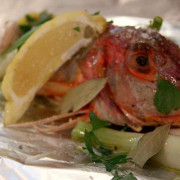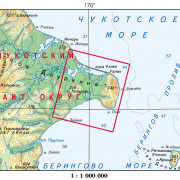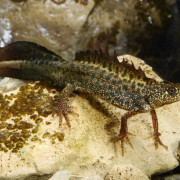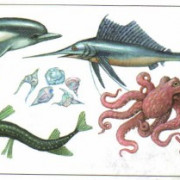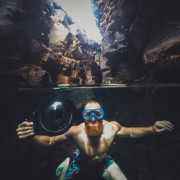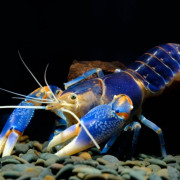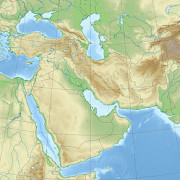Рыба латимерия
Содержание:
References
- ^
- ^
- ^ Butler, Carolyn (March 2011). «Living Fossil Fish». National Geographic: 86–93.
- ^ Forey, Peter L (1998). History of the Coelacanth Fishes. London: Chapman & Hall. ISBN 978-0-412-78480-4.[page needed]
- ^ Smith, J. L. B. (1956). Old Fourlegs: the Story of the Coelacanth. Longmans Green.
- ^
- ^
- ^
- ^
- ^
- Venter, P.; Timm, P.; Gunn, G.; le Roux, E.; Serfontein, C. (2000). «Discovery of a viable population of coelacanths (Latimeria chalumnae Smith, 1939) at Sodwana Bay, South Africa». South African Journal of Science. 96 (11/12): 567–568.
- Piper, Ross (2007). Extraordinary Animals: An Encyclopedia of Curious and Unusual Animals. Greenwood Press. ISBN 978-0-313-33922-6.[page needed]
- ^
- ^ Nelson, Joseph S. (2006). Fishes of the World. Hoboken, New Jersey: John Wiley. ISBN 978-0-471-75644-6.[page needed]
- ^
- ^
- ^
- ^
- Nelson, Joseph S. (2006). Fishes of the World. John Wiley & Sons. p. 601. ISBN 978-0-471-25031-9.
- ^
- ^ Long, J. A. (1995). The rise of fishes: 500 million years of evolution. Baltimore: Johns Hopkins University Press.[page needed]
- ^ Cloutier, R.; Ahlberg, P. E. (1996). Morphology, characters, and the interrelationships of basal sarcopterygians. pp. 445–79.
- ^
- ^
- ^
Естественные враги латимерий
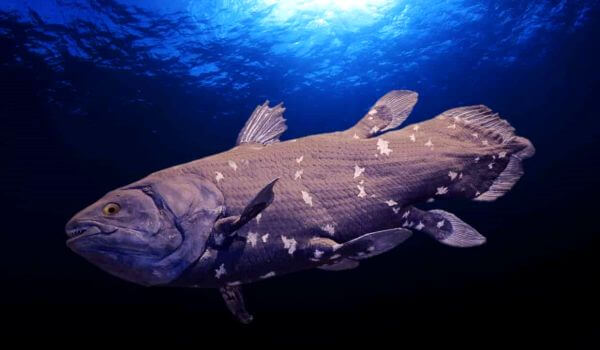
Фото: Рыба латимерия
Взрослая латимерия – рыба крупная и, несмотря на медлительность, способна себя защитить. Из соседствующих обитателей океанов без особых проблем с ней могут расправиться только крупные акулы. Потому лишь их латимерии и боятся – ведь акулы едят практически всё, что только попадается на глаза.
Даже специфический вкус мяса латимерии, сильно отдающий тухлятиной, их нисколько не смущает – ведь они не прочь съесть и настоящую падаль. Зато этот вкус в какой-то способствовал сохранению латимерий – живущие поблизости от мест их обитания люди, в отличие от учёных, знали о них издавна, но в пищу почти не употребляли.
Но иногда всё же ели, потому как считали, что мясо латимерий эффективно против малярии. В любом случае, их вылов не был активен, так что популяция, вероятно, сохранялась примерно на одном уровне. Серьёзно пострадали они в то время, когда образовался настоящий чёрный рынок, на котором продавали жидкость из их необычной хорды.
References
- ^
- ^
- ^ Butler, Carolyn (March 2011). «Living Fossil Fish». National Geographic: 86–93.
- ^ Forey, Peter L (1998). History of the Coelacanth Fishes. London: Chapman & Hall. 978-0-412-78480-4.
- ^ Smith, J. L. B. (1956). Old Fourlegs: the Story of the Coelacanth. Longmans Green.
- ^
- ^
- ^
- ^
- ^
- Venter, P.; Timm, P.; Gunn, G.; le Roux, E.; Serfontein, C. (2000). «Discovery of a viable population of coelacanths (Latimeria chalumnae Smith, 1939) at Sodwana Bay, South Africa». South African Journal of Science. 96 (11/12): 567–568.
- (2007). Extraordinary Animals: An Encyclopedia of Curious and Unusual Animals. . 978-0-313-33922-6.
- ^
- ^ Nelson, Joseph S. (2006). Fishes of the World. Hoboken, New Jersey: John Wiley. 978-0-471-75644-6.
- ^
- ^
- ^
- ^
- Nelson, Joseph S. (2006). Fishes of the World. . p. 601. 978-0-471-25031-9.
- ^
- ^ Long, J. A. (1995). The rise of fishes: 500 million years of evolution. Baltimore: Johns Hopkins University Press.
- ^ Cloutier, R.; Ahlberg, P. E. (1996). Morphology, characters, and the interrelationships of basal sarcopterygians. pp. 445–79.
- ^
- ^
- ^
Physical descriptionedit
Reconstruction of West Indian Ocean coelacanth
Preserved Latimeria menadoensis, Tokyo Sea Life Park, Japan
Coelacanths are a part of the clade Sarcopterygii, or the lobe-finned fishes. Externally, several characteristics distinguish the coelacanth from other lobe-finned fish. They possess a three-lobed caudal fin, also called a trilobate fin or a diphycercal tail. A secondary tail extending past the primary tail separates the upper and lower halves of the coelacanth. Cosmoid scales act as thick armor to protect the coelacanth’s exterior. Several internal traits also aid in differentiating coelacanths from other lobe-finned fish. At the back of the skull, the coelacanth possesses a hinge, the intracranial joint, which allows it to open its mouth extremely wide. Coelacanths also retain an oil-filled notochord, a hollow, pressurized tube which is replaced by the vertebral column early in embryonic development in most other vertebrates. The coelacanth heart is shaped differently from that of most modern fish, with its chambers arranged in a straight tube. The coelacanth braincase is 98.5% filled with fat; only 1.5% of the braincase contains brain tissue. The cheeks of the coelacanth are unique because the opercular bone is very small and holds a large soft-tissue opercular flap. A spiracular chamber is present, but the spiracle is closed and never opens during development. Coelacanth also possess a unique rostral organ within the ethmoid region of the braincase. Also unique to extant coelacanths is the presence of a «fatty lung» or a fat-filled single-lobed vestigial lung, homologous to other fishes’ swim bladder. The parallel development of a fatty organ for buoyancy control suggest a unique specialization for deep-water habitats. There has also been discovered small, hard but flexible plates around the vestigial lung in adult specimen, though not around the fatty organ. The plates most likely had a regulation function for the volume of the lung. Due to the size of the fatty organ, researchers assume it’s responsible for the kidney’s unusual relocation. The two kidneys, which are fused into one, are located ventrally within the abdominal cavity, posterior to the cloaca.
Биология — Целакант — Описание
Целакант Эволюция История повторного открытия Ареал Образ жизни Питание Охрана Значение для человека
Внешний вид
Latimeria chalumnae
Строение скелета современного целаканта почти идентично скелету предков, живших 200 миллионов лет назад. Окраска L. chalumnae синевато-серая с большими серо-белыми пятнами, располагающимися по всему телу, голове, и мускулистым основаниям плавников. Рисунок, сформированный белыми пятнами, является индивидуальным для каждой отдельной особи рыбы, что используется для идентификации при подводных наблюдениях.
Светлые пятна на теле напоминают оболочников, поселяющихся на стенах пещер, в которых обитают целаканты; также такие же оболочники является характерным элементом ландшафта, в котором обитают целаканты. Таким образом, данный тип окраски обеспечивает маскировку в соответствующем биотопе. Умирающий коморский целакант вместо синеватого цвета приобретает коричневый; в то же время индонезийские целаканты окрашены в коричневый цвет на протяжении всей жизни, с заметным золотистым блеском на светлых пятнах.
Самки обоих видов вырастают в длину в среднем до 190 см, самцы до 150, при весе 50—90 кг; Рождаются целаканты 35—38 сантиметров длиной.
Особенности анатомии
Исследование современных целакантов выявили, что они имеют много общих черт с хрящевыми рыбами. Эти черты были интерпретированы как «признаки примитивных позвоночных», но, наряду с ними, целаканты имеют больше развитых специализированных деталей строения тела. Наиболее яркой характеристикой целакантов является наличие специфических лопастных плавников. Несмотря на то, что данные плавники имеют ряд общих признаков с лопастевыми плавниками ископаемых легочных рыб и некоторых многоперистых, никакая другая группа рыб не развила сразу семь лопастевых плавников такого строения. Парные плавники целакантов поддерживаются костными поясами, которые напоминают структуры, являющиеся эволюционными предшественниками плечевого и тазового поясов наземных четвероногих позвоночных. Осевой скелет целакантов эволюционировал независимо от других позвоночных, даже обладающих нотохордой. Вместо развития позвонков, нотохорда современных целакантов развилась в трубку диаметром около 4 сантиметров, заполненную жидкостью под избыточным давлением. Нейрокраниум целакантов разделен внутренним суставом на переднюю и заднюю части, и это позволяет рыбам открывать рот не только с помощью опускания нижней челюсти, но также поднимая верхнюю. Это существенным образом увеличивает ротовое отверстие, и, повышая объем ротовой полости, обеспечивая усиленное всасывание. Взрослые целаканты обладают очень небольшим головным мозгом, который занимает лишь 1,5 % от общего объема черепной коробки. Эта черта общая с многими глубоководными акулами и шестижаберным электрическим скатом. Эпифизарный комплекс, обеспечивающий фоторецепцию у многих позвоночных, у целакантов относительно примитивный и слабо выраженный, в то время как базальный сосочек во внутреннем усе имеет сходство с таким у наземных позвоночных. Электросенсорные органы на голове и горловой пластинке целакантов, вместе с ростральными органами, исследователи считают средствами локации добычи. Для пищеварительной системы целакантов характерно наличие спирального клапана с уникальными, чрезвычайно удлиненными, почти параллельными спиральными конусами в кишечнике. Спиральный кишечник черта, характерная для предшествующих форм челюстных рыб, прогрессивно редуцированная у современных хрящевых рыб и замещенная удлинением кишечника у костистых рыб и тетрапод. Сердце целакантов удлинено, оно имеет структуру, аналогичную таковой у других рыб, и намного сложнее S-образной эмбриональной трубки, являющейся предыдущей формой для всех классов рыб. Согласно опубликованным в 1994 году данным, Latimeria chalumnae, пойманная в 1991 году возле Гахаи, имела кариотип, состоявший из 48 хромосом. Этот кариотип заметно отличается от кариотипа легочных рыб, но очень похож на 46-хромосомный кариотип ископаемой жабы Ascaphus truei. Комплекс дермальных каналов, известный лишь у ископаемых бесчелюстных и некоторых, также ископаемых, челюстных рыб, у L. chalumnae существует вместе с обычным для современных рыб рядом ямок, образующих «боковую линию».
|
Хурма эбеновая |
Целебесская черепаха >>> |
Fossil record
Undina penicillata
According to genetic analysis of current species, the divergence of coelacanths, lungfish and tetrapods is thought to have occurred about 390 million years ago. Coelacanths were once thought to have become extinct 66 million years ago during the Cretaceous–Paleogene extinction event. The first recorded coelacanth fossil, found in Australia, was of a jaw that dated back 360 million years, named Eoachtinistia foreyi. The most recent genus of coelacanth in the fossil record is Megalocoelacanthus, whose disarticulated remains are found in Campanian to possibly earliest Maastrichtian-aged marine strata of the Eastern and Central United States. A small bone fragment from the European Paleocene has been considered the only plausible post-Cretaceous record, but this identification is based on comparative bone histology methods of doubtful reliability.
The fossil record is unique because coelacanth fossils were found 100 years before the first live specimen was identified. In 1938, Courtenay-Latimer rediscovered the first live specimen, L. chalumnae, caught off the coast of East London, South Africa. In 1997, a marine biologist on honeymoon discovered the second live species, Latimeria menadoensis, in an Indonesian market.
In July 1998, the first live specimen of Latimeria menadoensis was caught in Indonesia. Approximately 80 species of coelacanth have been described, including the two extant species. Before the discovery of a live specimen, the coelacanth time range was thought to have spanned from the Middle Devonian to the Upper Cretaceous period. Although fossils found during that time were claimed to demonstrate a similar morphology, recent studies have expressed the view that coelacanth morphologic conservatism is a belief not based on data.
The following cladogram is based on multiple sources.
| Coelacanthiformes |
|
||||||||||||||||||||||||||||||||||||||||||||||||||||||||||||||||||||||||||||||||||||
Taxonomy
In Late Devonian vertebrate speciation, descendants of pelagic lobe-finned fish—like Eusthenopteron—exhibited a sequence of adaptations: Panderichthys, suited to muddy shallows; Tiktaalik with limb-like fins that could take it up onto land; and Early tetrapods in weed-filled swamps, such as Acanthostega which had feet with eight digits and Ichthyostega with limbs. Descendants also included pelagic lobe-finned fish such as the coelacanth species.
The following is a classification of known coelacanth genera and families:
-
Order Coelacanthiformes
-
Family Whiteiidae (Triassic)
- Piveteauia
- Whiteia
-
Family Rebellatricidae
Rebellatrix
(Triassic)
-
Family Coelacanthidae (Permian to Cretaceous)
- Axelia
- Coelacanthus
- Indocoelacanthus
- Wimania
-
Suborder Latimerioidei
-
Family Mawsoniidae (Triassic to Jurassic)
- Alcoveria
- Axelrodichthys
- Chinlea
- Diplurus
- Garnbergia
- Mawsonia
- Parnaibaia
-
Family Latimeriidae L. S. Berg, 1940 (Triassic to Holocene)
- Holophagus
-
Latimeria J. L. B. Smith, 1939
- Latimeria chalumnae J. L. B. Smith, 1939 (West Indian Ocean coelacanth)
- Latimeria menadoensis Pouyaud, Wirjoatmodjo, Rachmatika, Tjakrawidjaja, Hadiaty & Hadie, 1999 (Indonesian coelacanth)
- Libys
- Macropoma
- Macropomoides
- Ticinepomis
- Foreyia
- Swenzia
- Undina
- Megacoelacanthus
-
Family Mawsoniidae (Triassic to Jurassic)
-
Family Whiteiidae (Triassic)
General description
West Indian Ocean coelacanth caught on 21 January 1965, near Mutsamudu (Anjouan, Comoro Islands)
Pectoral fin of a West Indian Ocean coelacanth
Latimeria chalumnae and L. menadoensis are the only two known living coelacanth species. The word «coelacanth» is derived from the Greek for “hollow spine”, because of the fish’s unique hollow spine fins. Coelacanths are large, plump, lobe-finned fish that can grow to more than 2 meters (6 feet 6 inches) and weigh around 90 kilograms (200 pounds). They are estimated to live for 60 years or more. Modern coelacanths appear larger than those found as fossils.
They are nocturnal piscivorous drift-hunters. The body is covered in cosmoid scales that act as armor. Coelacanths have eight fins – 2 dorsal fins, 2 pectoral fins, 2 pelvic fins, 1 anal fin and 1 caudal fin. The tail is very nearly equally proportioned and is split by a terminal tuft of fin rays that make up its caudal lobe. The eyes of the coelacanth are very large, while the mouth is very small. The eye is acclimatized to seeing in poor light by rods that absorb mostly short wavelengths. Coelacanth vision has evolved to a mainly blue-shifted color capacity.Pseudomaxillary folds surround the mouth and replace the maxilla, a structure absent in coelacanths. Two nostrils, along with four other external openings, appear between the premaxilla and lateral bones. The nasal sacs resemble those of many other fish and do not contain an internal nostril. The coelacanth’s rostral organ, contained within the ethmoid region of the braincase, has three unguarded openings into the environment and is used as a part of the coelacanth’s laterosensory system. The coelacanth’s auditory reception is mediated by its inner ear, which is very similar to that of tetrapods because it is classified as being a basilar papilla.
Coelacanth locomotion is unique. To move around they most commonly take advantage of up- or down-wellings of current and drift. Their paired fins stabilize movement through the water. While on the ocean floor, they do not use the paired fins for any kind of movement. Coelacanths create thrust with their caudal fins for quick starts. Due to the abundance of its fins, the coelacanth has high maneuverability and can orient its body in almost any direction in the water. They have been seen doing headstands as well as swimming belly up. It is thought that the rostral organ helps give the coelacanth electroperception, which aids in movement around obstacles.
DNA
In 2013, a group led by Chris Amemiya and Neil Shubin published the genome sequence of the coelacanth in the journal Nature. The African coelacanth genome was sequenced and assembled using DNA from a Comoros Islands Latimeria chalumnae specimen. It was sequenced by Illumina sequencing technology and assembled using the short read genome assembler .
Due to their lobed fins and other features, it was once hypothesized that the coelacanth might be the most recent shared ancestor between terrestrial and marine vertebrates. But after sequencing the full genome of the coelacanth, it was discovered that the lungfish is the most recent shared ancestor. Coelacanths and lungfish had already diverged from a common ancestor before the lungfish made the transition to land.
Another important discovery made from the genome sequencing is that the coelacanths are still evolving today (but at a relatively slow rate). While they were initially thought to be a prehistoric species that remained unchanged over millions of years, the discovery that they are still evolving, albeit slowly, causes some to question whether «living fossil» is an appropriate descriptor.
One reason the coelacanths are evolving so slowly is the lack of evolutionary pressure on these organisms. They have few predators, and live deep in the ocean where conditions are very stable. Without much pressure for these organisms to adapt to survive, the rate at which they have evolved is much slower compared to other organisms.
Discovery
The coelacanth, which is related to lungfishes and tetrapods, was believed to have been extinct since the end of the Cretaceous period. More closely related to tetrapods than to the ray-finned fish, coelacanths were considered transitional species between fish and tetrapods. On 23 December 1938, the first Latimeria specimen was found off the east coast of South Africa, off the Chalumna River (now Tyolomnqa). Museum curator Marjorie Courtenay-Latimer discovered the fish among the catch of a local angler, Captain Hendrick Goosen. Latimer contacted a Rhodes University ichthyologist, J. L. B. Smith, sending him drawings of the fish, and he confirmed the fish’s importance with a famous cable: «MOST IMPORTANT PRESERVE SKELETON AND GILLS = FISH DESCRIBED.»
Its discovery 66 million years after it was believed to have become extinct makes the coelacanth the best-known example of a Lazarus taxon, an evolutionary line that seems to have disappeared from the fossil record only to reappear much later. Since 1938, West Indian Ocean coelacanth have been found in the Comoros, Kenya, Tanzania, Mozambique, Madagascar, and in iSimangaliso Wetland Park, Kwazulu-Natal in South Africa.
The Comoro Islands specimen was discovered in December 1952. Between 1938 and 1975, 84 specimens were caught and recorded.
The second extant species, Indonesian coelacanth, was described from Manado, North Sulawesi, Indonesia in 1999 by Pouyaud et al. based on a specimen discovered by Mark V. Erdmann in 1998 and deposited at the Indonesian Institute of Sciences (LIPI). Erdmann and his wife Arnaz Mehta first encountered a specimen at a local market in September 1997, but took only a few photographs of the first specimen of this species before it was sold. After confirming that it was a unique discovery, Erdmann returned to Sulawesi in November 1997 to interview fishermen to look for further examples. A second specimen was caught by a fisherman in July 1998 and it was then handed to Erdmann.
The coelacanth has no real commercial value apart from being coveted by museums and private collectors. As a food fish it is considered worthless, as its tissues exude oils that give the flesh a distinctly unpleasant flavor. The coelacanth’s continued survival may be threatened by commercial deep-sea trawling, in which coelacanths are caught as bycatch.
Conservation
Coelacanth
Coelacanth at Abdallah Al Salem Cultural Center in Kuwait
Because little is known about the coelacanth, the conservation status is difficult to characterize. According to Fricke et al. (1995), there should be some stress put on the importance of conserving this species. From 1988 to 1994, Fricke counted some 60 individuals of L. chalumnae on each dive. In 1995 that number dropped to 40. Even though this could be a result of natural population fluctuation, it also could be a result of overfishing. The IUCN currently classifies L. chalumnae as Critically Endangered, with a total population size of 500 or fewer individuals.L. menadoensis is considered Vulnerable, with a significantly larger population size (fewer than 10,000 individuals).
Currently, the major threat towards the coelacanth is the accidental capture by fishing operations. Coelacanths usually are caught when local fishermen are fishing for oilfish. Fishermen sometimes snag a coelacanth instead of an oilfish because they traditionally fish at night, when oilfish (and coelacanths) feed.
Before scientists became interested in coelacanths, they were thrown back into the water if caught. Now that there is an interest in them, fishermen trade them in to scientists or other officials once they have been caught. Before the 1980s, this was a problem for coelacanth populations. In the 1980s, international aid gave fiberglass boats to the local fishermen, which resulted in fishing beyond the coelacanth territories into more fish-productive waters. Since then, most of the motors on the boats have broken down so the local fishermen are now back in the coelacanth territory, putting the species at risk again.
Different methods to minimize the number of coelacanths caught include moving fishers away from the shore, using different laxatives and malarial salves to reduce the quantity of oilfish needed, using coelacanth models to simulate live specimens, and increasing awareness of the need to protect the species. In 1987 the Coelacanth Conservation Council advocated the conservation of coelacanths. The CCC has many branches of its agency located in Comoros, South Africa, Canada, the United Kingdom, the U.S., Japan and Germany. The agencies were established to help protect and encourage population growth of coelacanths.
A «Deep Release Kit» was developed in 2014 and distributed by private initiative, consisting of a weighted hook assembly that allows a fisherman to return an accidentally caught coelacanth to deep waters where the hook can be detached once it hits the sea floor. Conclusive reports about the effectiveness of this method are still pending.
In 2002, the South African Coelacanth Conservation and Genome Resource Programme was launched to help further the studies and conservation of the coelacanth. This program focuses on biodiversity conservation, evolutionary biology, capacity building, and public understanding. The South African government committed to spending R10 million on the program.
In 2011, a plan for a Tanga Coelacanth Marine Park was designed to conserve marine biodiversity for marine animals including the coelacanth. The park was designed to reduce habitat destruction and improve prey availability for endangered species.
Life historyedit
Fossil of Axelrodichthys araripensis, an extinct coelacanthiform
Latimeria chalumnae embryo with its yolk sac from the Muséum national d’histoire naturelle
Coelacanths are ovoviviparous, meaning that the female retains the fertilized eggs within her body while the embryos develop during a gestation period of over a year. Typically, females are larger than the males; their scales and the skin folds around the cloaca differ. The male coelacanth has no distinct copulatory organs, just a cloaca, which has a urogenital papilla surrounded by erectile caruncles. It is hypothesized that the cloaca everts to serve as a copulatory organ.
Coelacanth eggs are large with only a thin layer of membrane to protect them. Embryos hatch within the female and eventually are given live birth, which is a rarity in fish. This was only discovered when the American Museum of Natural History dissected its first coelacanth specimen in 1975 and found it pregnant with five embryos. Young coelacanths resemble the adult, the main differences being an external yolk sac, larger eyes relative to body size and a more pronounced downward slope of the body. The juvenile coelacanth’s broad yolk sac hangs below the pelvic fins. The scales and fins of the juvenile are completely matured; however, it does lack odontodes, which it gains during maturation.
A study that assessed the paternity of the embryos inside two Coelacanth females indicated that each clutch was sired by a single male. This could mean that females mate monandrously, i.e. with one male only. Polyandry, female mating with multiple males, is common in both plants and animals and can be advantageous (e.g. insurance against mating with an infertile or incompatible mate), but also confers costs (increased risk of infection, danger of falling prey to predators, increased energy input when searching for new males). Alternatively, the study’s results could indicate that, despite female polyandry, one male is used to fertilise all the eggs, potentially through female sperm choice or last-male sperm precedence.
Популяция и статус вида
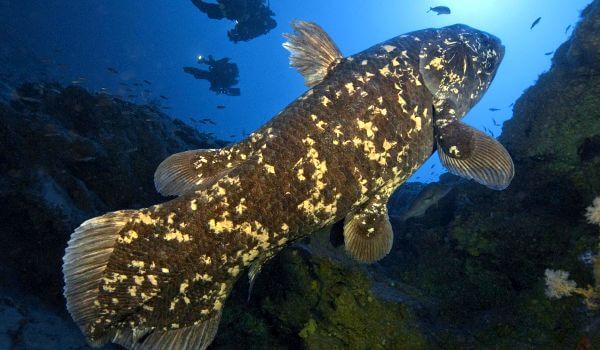
Фото: Кистеперая рыба латимерия
Индонезийский вид признан уязвимым, а коморский находящимся на грани исчезновения. Оба под охраной, их вылов запрещён. До официального открытия этих рыб, хотя местное население прибрежных территорий и знало о них, но специально не ловило, поскольку не употребляло в пищу.
После открытия какое-то время это продолжилось, но затем распространился слух, что добытая из их хорды жидкость способна продлить жизнь. Были и другие – например, что из них можно делать любовное зелье. Тогда, несмотря на запреты, их начали активно вылавливать, ведь цены на эту жидкость были очень высоки.
Активнее всего браконьеры были в 1980-е годы, в результате чего исследователи обнаружили, что популяция сократилась очень сильно, до критических значений – согласно их оценке, в районе Коморских островов к середине 1990-х осталось всего 300 латимерий. За счёт мер против браконьеров их численность удалось стабилизировать, и теперь она оценивается в 400-500 особей.
Сколько латимерий обитает у берегов Южной Африки и в море Сулавеси не установлено пока даже приблизительно. Предполагается, что их немного в первом случае (маловероятно, что речь идёт о сотнях особей). Во втором разброс может быть очень большим – ориентировочно от 100 до 1 000 особей.

